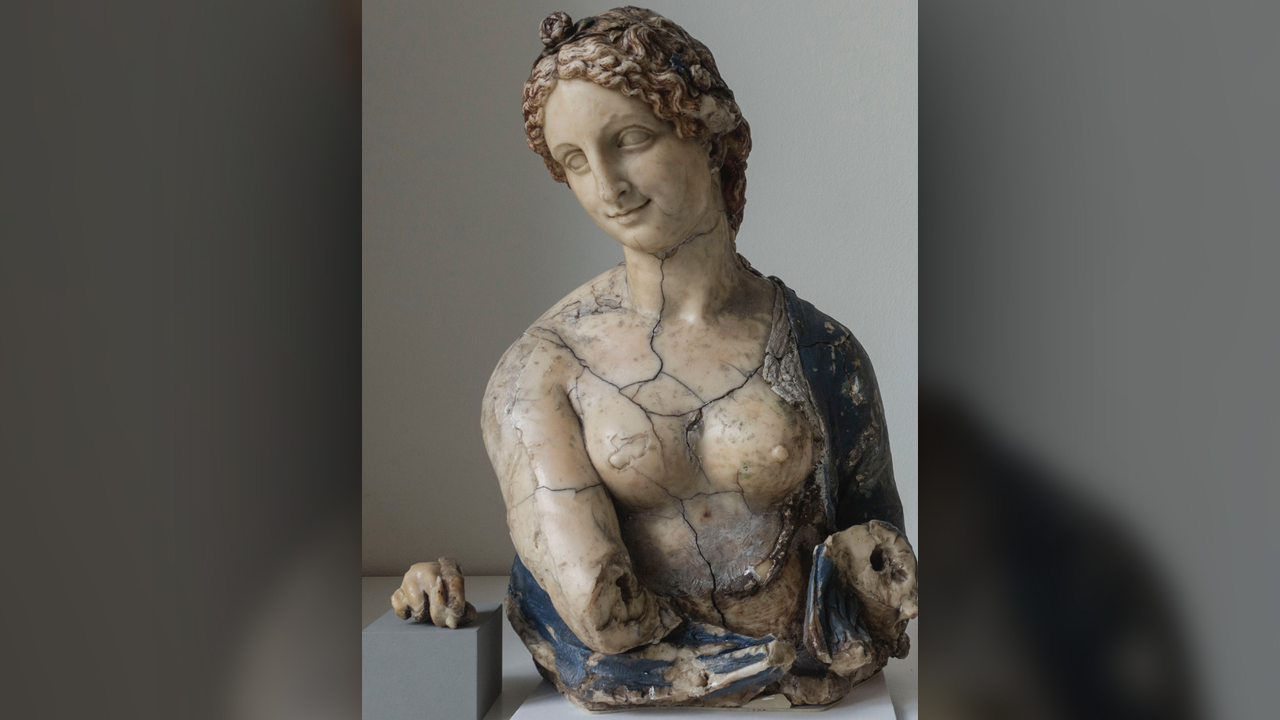Leonardo da Vinci didn’t carve the notorious 'Flora' bust, experts find
The goddess sculpture was created centuries after da Vinci's death.

A bust in the collection of Berlin's Bode Museum had long been attributed to the Renaissance artist Leonardo da Vinci, mostly because the woman's features resembled those of faces in da Vinci's paintings. However, there was no evidence directly connecting da Vinci to the sculpture of the goddess Flora — a Roman deity of flowering plants — and its origins have been hotly contested among art experts for over a century.
Now, researchers have definitively settled the debate: da Vinci was not Flora's creator.
The wax bust was crafted mostly from spermaceti, a waxy substance produced in the heads of sperm whales. This discovery prompted the scientists to apply a new calibration method in order to accurately date the object, revealing that Flora wasn't produced when da Vinci was alive (1452 to 1519). Instead, the bust was most likely carved during the 19th century, the researchers reported in a new study.
Related: 5 things you probably didn't know about Leonardo da Vinci
Flora has a serenely smiling face and stands about 28 inches (70 centimeters) tall, weighing approximately 62 pounds (28 kilograms). In 1909, the wax statue was acquired by Wilhelm von Bode, the founding director of the Kaiser Friedrich Museum (now the Bode Museum) in Berlin, who purchased the bust at auction and attributed the artwork to da Vinci, according to the Bode Museum.
However, within two years of the bust's acquisition, scholars across Europe published more than 730 articles questioning the sculpture's provenance. Chemical analysis of the wax, conducted in the 1900s, couldn't determine the statue's age but did detect traces of spermaceti, which was rare in Renaissance art objects and was more common in 19th-century sculptures. Another evaluation argued that the casting method did not reflect Renaissance techniques, and one investigation found 19th-century newspaper and wood fragments in the back of the bust (however, these could have been added during later modifications after the bust was sculpted, the study authors wrote).
"There are also historical documents that support a 19th c. attribution, including a statutory declaration by the son of Richard Cockle Lucas [a 19th-century British sculptor] stating that his father made the Flora bust in 1846," the scientists reported.
Sign up for the Live Science daily newsletter now
Get the world’s most fascinating discoveries delivered straight to your inbox.
"Cannot be attributed to Leonardo"
In the new study, the researchers conducted a chemical analysis, which showed that the bust was mostly made of spermaceti, mixed with some beeswax. The researchers then dated wax samples from the bust by measuring the decay of carbon-14 — a radioactive form of carbon — calibrating those calculations to reflect that the wax came from animals in a marine environment. By comparing their wax analysis to carbon-14 measurements from other marine sources, they were able to create a date range for the bust that was more accurate than previous carbon-14 estimates, according to the study.
"All of the analyzed constituents of the Flora bust are dated after 1700 A.D.," the researchers wrote. "The result dates the Flora materials to the 18-19th c., which proves that the bust was not produced during the Renaissance, and therefore cannot be attributed to Leonardo."
Spermaceti's widespread use in art objects dates to the 18th century, and reflects a general use of sperm whale products at the time — a result of the whaling boom during the Industrial Revolution. Though it was "somewhat disappointing" to prove that da Vinci wasn't Flora's creator, the investigation did provide valuable insights, demonstrating a link between cultural objects, industry and humans' interactions with the natural world, the researchers reported.
The findings were published online April 15 in the journal Scientific Reports.
Originally published on Live Science.

Mindy Weisberger is an editor at Scholastic and a former Live Science channel editor and senior writer. She has reported on general science, covering climate change, paleontology, biology and space. Mindy studied film at Columbia University; prior to Live Science she produced, wrote and directed media for the American Museum of Natural History in New York City. Her videos about dinosaurs, astrophysics, biodiversity and evolution appear in museums and science centers worldwide, earning awards such as the CINE Golden Eagle and the Communicator Award of Excellence. Her writing has also appeared in Scientific American, The Washington Post and How It Works Magazine. Her book "Rise of the Zombie Bugs: The Surprising Science of Parasitic Mind Control" will be published in spring 2025 by Johns Hopkins University Press.
Why is yawning contagious?
Scientific consensus shows race is a human invention, not biological reality










